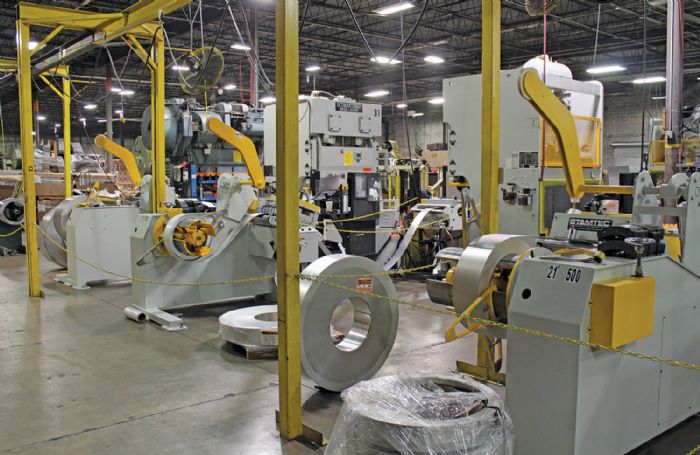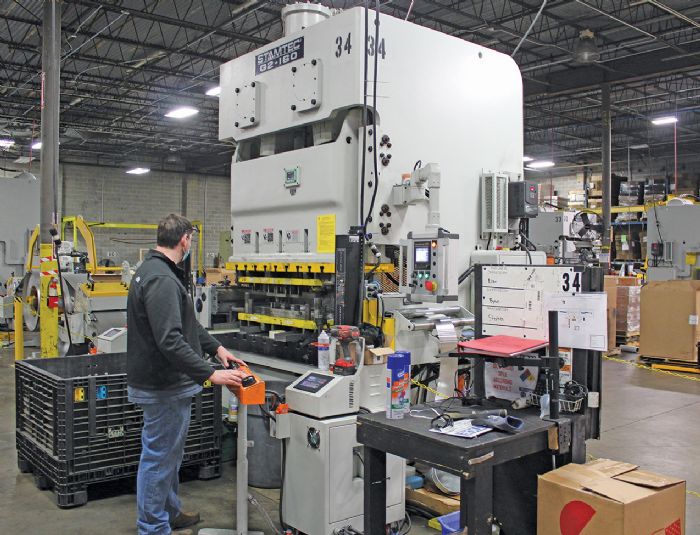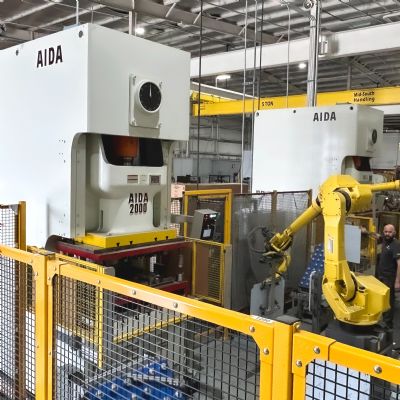It’s Raining Pressroom Technology
March 31, 2022Comments
…at rainwear-products manufacturer Spectra Gutter Systems, where eight new mechanical stamping presses installed in the last 2 yr., complete with new servo coil-feed lines and all delivered turnkey, have transformed the firm’s pressroom into a state-of-the-art production operation.
During the past several months, rainwear-industry manufacturer Spectra Gutter Systems has completely revamped its pressroom, one of five buildings on its Atlanta, GA, campus. The stamping plant is home to 30 presses, 75 employees and dozens of dies. It stamps a variety of rainware products including gutter end caps, outlets, miters and hangers in several styles and sizes.
 “When we set a die, to optimize efficiency we run it as long as possible,” says Kevin Thompson, corporate product engineer. And lately, the firm has been setting dies in a bevy of brand-new mechanical stamping presses.
“When we set a die, to optimize efficiency we run it as long as possible,” says Kevin Thompson, corporate product engineer. And lately, the firm has been setting dies in a bevy of brand-new mechanical stamping presses.
“For years we only purchased used or rebuilt presses,” Thompson adds, “which typically bring reliability concerns. Our goal is to be a worldclass manufacturer (Spectra also operates manufacturing facilities in Clearwater, FL, Indianapolis, IN, and Dallas, TX). To get there, we realized that we had to invest in new pressroom technology. For that we sought to partner with a supplier that could deliver turnkey press lines, including new feeds.”
Spectra Gutter Systems’ pressroom-technology partner: Stamtec Inc. and its machine distributor Manufacturing Technology, LLC (M-Tech), Birmingham, AL.
Grow Capacity and Throughput, and Boost Reliability
Spectra’s pressroom upgrade launched during the summer of 2021 when it installed two new press lines, anchored by a 160-ton press and a 110-ton model. To date, it has installed six 110-ton models and two 160-ton presses, with the last installed in March 2022.
“We don’t need a lot of press tonnage,” says Thompson, “as we’re primarily stamping thin-gauge aluminum no thicker than 0.063 in.”
Much of the material is painted inhouse, via slitting and coil-coating operations. And while the firm has been investing in new technology, “we’re also trying to get smarter about how we develop our tools to optimize productivity,” Thompson adds. “Much of that development is proprietary but suffice to say that as order volume for gutter accessories continues to rise, improving press speed and parts out per hit are top of mind.”







 With the new presses came new servo feeds—two different model numbers from Stamtec. The LUH/NCF-series coil lines—Spectra has two models—feature two-in-one uncoiler/ straightener (nine rolls) units; manually operated coil keepers; and loop-control light sensors, paired with separate servo feeders. The lines boast a maximum working speed of 16 m/min. One model, the LUH/NCF-400, offers a maximum coil width of 153⁄4 in. and coil weight to 4400 lb.; model LUH/NCF-500 coil lines feed coils to 19.7 in. wide and weighing as much as 6600 lb. Thompson greatly appreciates the benefits of servo-feed technology.
With the new presses came new servo feeds—two different model numbers from Stamtec. The LUH/NCF-series coil lines—Spectra has two models—feature two-in-one uncoiler/ straightener (nine rolls) units; manually operated coil keepers; and loop-control light sensors, paired with separate servo feeders. The lines boast a maximum working speed of 16 m/min. One model, the LUH/NCF-400, offers a maximum coil width of 153⁄4 in. and coil weight to 4400 lb.; model LUH/NCF-500 coil lines feed coils to 19.7 in. wide and weighing as much as 6600 lb. Thompson greatly appreciates the benefits of servo-feed technology.
